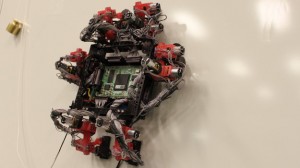I have two items one of which concerns Lomiko Metals and the other, a new institute focused on extraction launched jointly by the University of British Columbia (UBC), Simon Fraser University (SFU) and l’École Polytechnique de Montréal (EPM).
First, there’s a puzzling Jan. 28, 2014 news item on Nanowerk about Lomiko Metals (a company that extracts graphite flakes from the Quatre Milles property in Québec, and its appearance at the 2014 World Outlook Financial Conference being held in Vancouver,
Lomiko Metals Inc. invite [sic] investors to learn about 3d printing at the World Outlook Conference. Lomiko partner Graphene 3D Lab has reached a significant milestone by filing a provisional patent application for the use of graphene-enhanced material, along with other materials, in 3D Printing. 3D printing or additive manufacturing is the process of creating a three-dimensional, solid object from a digital file, of virtually any shape. 3D printing is achieved using an additive process, whereas successive layers of material are laid down and create different shapes.
Unsure as to whether or not Lomiko Metals would be offering demonstrations of 3D printed items containing graphene at the conference, I sent a query to the company’s Chief Executive Officer, A. Paul Gill who kindly replied with this,
The demonstration being done is by the Conference not by Lomiko. We were going to do something at our booth but we didn’t want to steal any thunder from the WOC or Tinkinerine which is a 3D Printing manufacturer and is going public through a merger with White Bear Resources. (TSX-V: WBR).
The Jan. 27, 2013 [sic] Lomiko Metals news release, which originated the news item, did have this to say about graphene and 3D printing (Note: I live in dread of accidentally writing 2013 when I mean 2014),
Adding graphene to polymers which are conventionally u sed in 3D printing improves the properties of the polymer in many different ways; it improves the polymers mechanical strength as well as its electrical and thermal conductivity. The method described in the provisional patent application allows consumers to use the polymer, infused with graphene, together with conventional polymers in the same printing process, thereby fabricating functional electronic devices using 3D printing.
New developments in 3D printing will allow for the creation of products with different components, such as printed electronic circuits, sensors, or batteries to be manufactured. 3D Printing is a new and promising manufacturing technology that has garnered much interest, growing from uses in prototyping to everyday products. Today, it is a billion dollar industry growing at a brisk pace.
For those eager to find out about investment opportunities in 2014, here’s the World Financial Outlook Conference website. I was surprised they don’t list the conference dates on the homepage (Jan. 31 – Feb. 1,2014) or any details other than the prices for various categories of registration. There is a Speakers page, which lists John Biehler as their 3D printing expert,
John Biehler is a Vancouver based photographer, blogger, gadget geek, mobile phone nerd, teacher, traveler, 3D printer builder/operator, maker & all around curious person.
He co-founded 3D604.org, a club of 3d printing enthusiasts who meet monthly and help share their knowledge of 3d printing at many events. He has spoken at numerous conferences including SXSW Interactive, Northern Voice, BarCamp and many others.
John is a regular contributor to Miss604.com, the DottoTech radio show, the Province newspaper and London Drugs blogs as well as doing a weekly Tech Tuesday segment on News 1130 radio and many other online, print, radio and television outlets. He is currently writing his first book (about 3D printing) that will be published in 2014 by Que.
You can find the conference agenda here. Biehler’s talk “3D Printing: The Future is Now” is scheduled for Saturday, Feb. 1, 2014 at 10:45 am PDT.
Sustainable extraction
A January 29, 2014 University of British Columbia (UBC) news release announced this (Note: Links have been removed),
International sustainable mining institute launched
A new Canadian institute that will help developing countries benefit from their mining resources in environmentally and socially responsible ways was officially launched in Vancouver today.
The Canadian International Institute for Extractive Industries and Development (CIIEID) is a coalition between the University of British Columbia, Simon Fraser University, and École Polytechnique de Montréal (EPM). Institute Interim Executive Director Bern Klein was joined for the launch in Vancouver by UBC’s Vice President Research & International John Hepburn, SFU President Andrew Petter, and EPM CEO Christophe Guy.
“Nations want to develop their mineral, oil and gas resources,” says Klein, also a professor of mining engineering at UBC. “But many lack the regulatory and policy frameworks to make the most of their natural resources, while also considering the needs of affected communities. We want them to have the capacity to use their resources to enhance livelihoods, improve dialogue and mitigate environmental harm.”
In November 2012 the Department of Foreign Affairs, Trade and Development (then CIDA) announced the award of $25 million to a coalition of the three academic institutions to form the Institute. Since then, the Institute has set up operations and is connecting with partner nongovernmental organizations, governments, professional associations, and industry. It is now beginning program development.
Programming will put the Institute and its partners’ knowledge and resources at the service of foreign governments and local communities. Its work will focus on four main areas: applied research, community engagement, education, and governance of natural resources.
For more information about the Institute, visit the website at: http://ciieid.org.
I have searched the CIIEID website to find out how the government or anyone else for that matter determined that Canadians have any advice about or examples of sustainable extraction to offer any other country. I remain mystified. Perhaps someone reading this blog would care to enlighten me.
